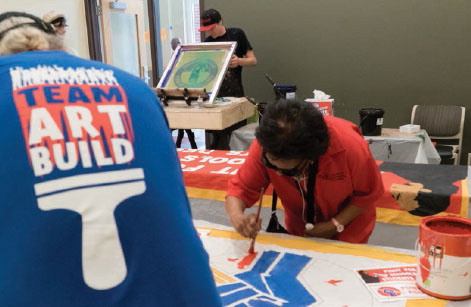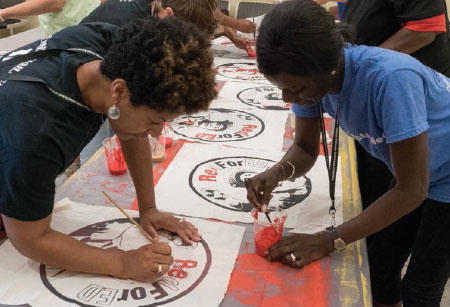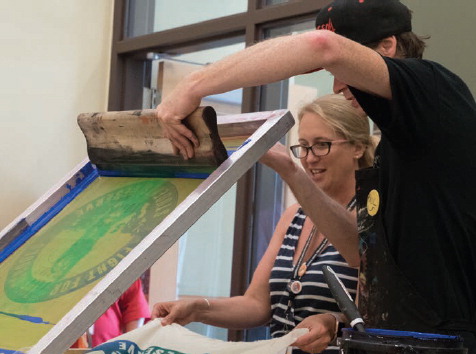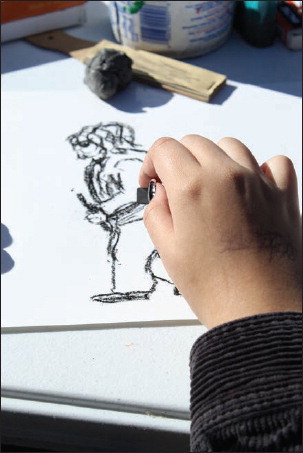This is the second special issue of 2019 devoted to understanding entrepreneurship as a part of art education. Readers previously were introduced to entrepreneurship as a form of creative destruction. That lens brought forth new questions and research about emerging practices and innovations in art education (CitationKraehe, 2019).
In this issue, authors continue the conversation by illuminating entrepreneurship in the form of creative advocacy. Art and museum educators have always been strong advocates for the arts. They understand its value to individuals and society, and many are active in promoting the arts in education through formal organizations like the National Art Education Association (NAEA), as part of grassroots networks, and on their own.
Advocacy is part and parcel of being an art educator. It is how many exercise leadership in their local schools and communities, before state boards of education, and at the national level (CitationNational Art Education Association, 2009; see also, CitationBobick & DiCindio, 2012; CitationSaunders, 1979). These are places where decisions are made that have broad, and often lasting, impact. Thus, in addition to teaching art, advocacy is another important way in which art educators help shape human potential and improve public life.
Conventional approaches to advocacy involve persuading others to act in the interest of a worthy cause. According to art educator and researcher CitationRita Irwin (1993), “anyone who pleads for the cause of art in education and its unique position within our cultural fabric” (p. 71) is engaged in advocacy. Creative advocacy goes a step further to seek and inspire change (e.g., CitationBrown, 1979). Whereas conventional advocacy can be directed toward maintaining rather than changing current priorities, practices, and policies, creative advocacy is entrepreneurial in its aim to disrupt the status quo with out-of-the-box thinking and transform the existing state of affairs using new and alternative methods, tools, and tactics.
Conventional approaches to advocacy involve persuading others to act in the interest of a worthy cause….
CREATIVE ADVOCACY goes a step further to seek and inspire change.
In art education, entrepreneurship often finds expression in creative advocacy that addresses educational, cultural, social, and environmental problems. The recent art builds that have sprung up all over the United States are a vivid example of this. Art educator and activist CitationKim Cosier (2019) defines art builds as events that involve “artmaking with community members in service to movements for justice” (p. 261). The photographs in are snapshots of an art build in Maryland. Local educators were joined by Milwaukee's Art Build Workers, a group of artists, designers, and educators who travel across the country to teach advocacy and activist groups how to create aesthetic and visual forms that will help amplify their message. In Maryland, educators made patches and posters in support of Red For Ed, a teacher-led movement advocating that legislators reinvest in the public schools.
Photo credits: Milwaukee Teachers' Education Association (https://creativecommons.org/licenses/by-nc/2.0/)


Creative advocacy may spring from collective organizing, or it may begin with just one voice. The scale of its intervention may be grand or granular. In either case, I do not think size is the defining feature of entrepreneurship and creative advocacy. Perhaps more significant are qualities such as boldness to go where others have not yet gone, stand out from the crowd, say what needs to be said, and do what needs to be done; imagination to recognize or create opportunities to solve problems that matter; and determination to persevere until positive results are realized.
This special issue is a collection of research and recommendations to help readers think creatively about advocacy that advances the visual arts as an educational enterprise. Dana Carlisle Kletchka offers one possible road map that art and museum educators can use to organize and launch their own advocacy initiatives at the local, state, and national levels in “The Art of Advocacy: Lessons From the National Arts Action Summit and Arts Advocacy Day.”
Creative advocacy can address structures and conditions that shape teaching and learning in the visual arts. In “Facing the Elephant: Let's Talk About Art-on-a-Cart,” Samantha T. Nolte-Yupari raises awareness about art-on-a-cart, an overlooked and often misunderstood working condition that is nonetheless ubiquitous in schools. The author distills important themes across 30 years of literature on the topic and advocates for more research and professional development in support of art teachers who deliver instruction from an art cart. Magdeline Chilalu Mannathoko calls attention to new policies that promote the safe use of art materials and protective equipment in “Health and Safety Concerns in Art and Design Primary School Classrooms in Botswana: Reflections on the Art and Design Module.” The author presents key findings from a case study of policy implementation in primary schools and shares important takeaways for art teachers, their students, and supervisors.
Creative advocacy can also reframe an issue and persuade others to think differently about art in education. In “The Dangerous Power of Art Education,” Connie Stewart examines the everyday practices and priorities that art teachers enact in classrooms and argues that, although art has been relegated to marginal spaces in between other school subjects, art teachers are uniquely poised to challenge pedagogical norms and advance alternatives to current school policies.
Shannon E. Elliott and Jody Stokes-Casey investigate the way art and art teachers frequently have been categorized and organized within schools in “Not So Special: How Labels Affect Art Teachers.” They argue that labels have the power to shape art teachers' professional identities and morale and have served to devalue art teachers' work, and yet the Every Student Succeeds Act presents a new policy environment and a new opportunity—one in which art teachers alongside their advocates in the broader field of art education can reimagine and change the labels they adopt for themselves.
In “Becoming More Than My Title: From K–12 Art Teacher to Director of a University-Wide Entrepreneurship Initiative,” Sarabeth Berk writes about her hybrid professional identities and reflects on the complementary ways art and entrepreneurship have enabled her unconventional career path. The author offers recommendations about pursuing one's entrepreneurial impulses, creating a hybrid professional life, and seizing new opportunities—in short, how to advocate for oneself.
Two commentaries reflect on the relationship between entrepreneurship and art education. In “Sacrifices, or Creating Destruction,” Juuso Tervo explores figurative and actual destruction that attended past calls for progress and suggests greater sensitivity to this past could benefit art education in the present and future. As a response to current neoliberal, market-based practices and ways of thinking that have seeped into government, technology, and even education, Nadine M. Kalin advocates for art's autonomy from such forces in “Decreating Entrepreneurialized Art Education.”
In the Instructional Resources, titled “The Art of Paper Tearing With Sing Man Lee,” Dan Li spotlights Hong Kong–based folk artist, Sing Man Lee, whose paper-tearing performance works serve as a lens through which students may learn about a traditional Chinese art practice while also learning the entrepreneurial side of folk art that helps sustain local cultures, art forms, and communities.
There are multiple ways in which entrepreneurship is understood and practiced in art education today. It manifests as creative advocacy and creative destruction, as detailed in these last two Art Education issues of 2019, and is fundamentally change oriented. I have no doubt there are other forms just waiting to be identified. How and where will art education entrepreneurship evolve in the next decade? We invite you to ponder this and, if so inclined, send letters to the editor at the journal email address below. You can post your comments on our social media or NAEA's Collaborate.
![]() www.instagram.com/arteducationjournal
www.instagram.com/arteducationjournal
Author Note
I wish to recognize and thank Mireya Escobar for all the photographs featured in the September 2019 editorial. The photographs were not properly attributed to her at the time of publication.
Additional information
Notes on contributors
Amelia M. Kraehe
Amelia M. Kraehe, Associate Professor, Art and Visual Culture Education, School of Art, The University of Arizona in Tucson.
Notes
This editorial has been republished with minor changes. These changes do not impact the academic content of the editorial.
References
- Bobick, B., & DiCindio, C. (2012). Advocacy for art education: Beyond tee-shirts and bumper stickers. Art Education, 65(2), 20–23.
- Brown, T. (1979). Creative advocacy: A commitment to change. Art Education, 32(5), 26–27.
- Cosier, K. (2019). What can art and art education do in the perilous present? Studies in Art Education, 60(3), 260–268.
- Irwin, R. L. (1993). The four principles of art advocacy: Public awareness, professional development, policy-making, and patronage. Art Education, 46(1), 71–77.
- Kraehe, A. M. (2019). Entrepreneurship as creative destruction. Art Education, 72(5), 4–7.
- National Art Education Association. (2009). Professional standards for visual arts educators. Reston, VA: National Art Education Association.
- Saunders, K. (1979). Arts up front: Approaches to advocacy in the secondary school. Art Education, 32(5), 9–13.


